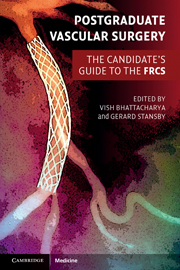Book contents
- Frontmatter
- Contents
- List of contributors
- Preface
- Section 1 Final FRCS vascular clinicals
- Section 2 Final FRCS vascular topics
- 1 Vascular risk factors and their management
- 2 Management of acute limb ischaemia
- 3 Chronic lower limb ischaemia, critical ischaemia and the diabetic foot
- 4 Endovascular and surgical options for peripheral revascularisation
- 5 Abdominal aortic aneurysms
- 6 Thoracic, thoracoabdominal and suprarenal aortic aneurysms
- 7 Aortic dissection
- 8 Popliteal artery aneurysms
- 9 Femoral artery aneurysms
- 10 Carotid, subclavian and vertebral disease
- 11 Diagnosis and management of thoracic outlet syndrome
- 12 Diagnosis and management of hyperhidrosis
- 13 Chronic mesenteric ischaemia
- 14 Acute ischaemic colitis
- 15 Vascular trauma
- 16 Indications and management of lower limb amputation
- 17 Leg swelling and lymphoedema
- 18 Varicose veins and chronic venous insufficiency
- 19 Management of deep vein thrombosis
- 20 Infection in vascular surgery
- 21 Vascular malformations
- 22 Vasospastic disorders and vasculitis
- 23 Critical care considerations and preoperative assessment for general and vascular surgery
- 24 Access surgery
- 25 Basic outline of solid organ transplantation
- Index
- References
14 - Acute ischaemic colitis
- Frontmatter
- Contents
- List of contributors
- Preface
- Section 1 Final FRCS vascular clinicals
- Section 2 Final FRCS vascular topics
- 1 Vascular risk factors and their management
- 2 Management of acute limb ischaemia
- 3 Chronic lower limb ischaemia, critical ischaemia and the diabetic foot
- 4 Endovascular and surgical options for peripheral revascularisation
- 5 Abdominal aortic aneurysms
- 6 Thoracic, thoracoabdominal and suprarenal aortic aneurysms
- 7 Aortic dissection
- 8 Popliteal artery aneurysms
- 9 Femoral artery aneurysms
- 10 Carotid, subclavian and vertebral disease
- 11 Diagnosis and management of thoracic outlet syndrome
- 12 Diagnosis and management of hyperhidrosis
- 13 Chronic mesenteric ischaemia
- 14 Acute ischaemic colitis
- 15 Vascular trauma
- 16 Indications and management of lower limb amputation
- 17 Leg swelling and lymphoedema
- 18 Varicose veins and chronic venous insufficiency
- 19 Management of deep vein thrombosis
- 20 Infection in vascular surgery
- 21 Vascular malformations
- 22 Vasospastic disorders and vasculitis
- 23 Critical care considerations and preoperative assessment for general and vascular surgery
- 24 Access surgery
- 25 Basic outline of solid organ transplantation
- Index
- References
Summary
Key points
Acute ischaemic colitis can be due to occlusive or non-occlusive causes
A high index of suspicion should be present in elderly patients presenting with sudden abdominal pain and bloody diarrhoea
Computed tomography (CT) scan may show a ‘halo sign’ and also rule out other abnormalities
D-Lactate is more specific for intestinal ischaemia than L-Lactate
Angiography and lysis may be considered in early cases with no sign of peritonitis
In case of bowel resection primary anastomosis is best avoided and a re-look laparotomy recommended
Postaneurysm repair colitis can be prevented by selective reimplantaion of the inferior mesenteric artery (IMA) in high risk cases
Introduction
Ischaemic colitis is the result of an event that leads to a reduction in colonic blood flow sufficient to cause ischaemia or infarction of the colonic wall but not sufficient to produce full thickness infarction and perforation.
The term ischaemic colitis was first introduced by Marston et al. in 1966. It is commonly due to acute thrombosis or embolism of the superior mesenteric artery (SMA) or IMA, causing compromise of the colonic blood supply or due to hypotension causing hypoperfusion and ischaemia.
The term is often used for cases where full thickness infarction is present acutely but this usage is incorrect – not all ischaemic colons have ischaemic colitis, although the two may coexist if the involvement is patchy.
Pathophysiology
The following causes predispose the colon to ischaemia more readily than the small bowel:
The colon differs from the small bowel in having no villi and therefore no countercurrent mechanism.
[…]
- Type
- Chapter
- Information
- Postgraduate Vascular SurgeryThe Candidate's Guide to the FRCS, pp. 164 - 171Publisher: Cambridge University PressPrint publication year: 2011

